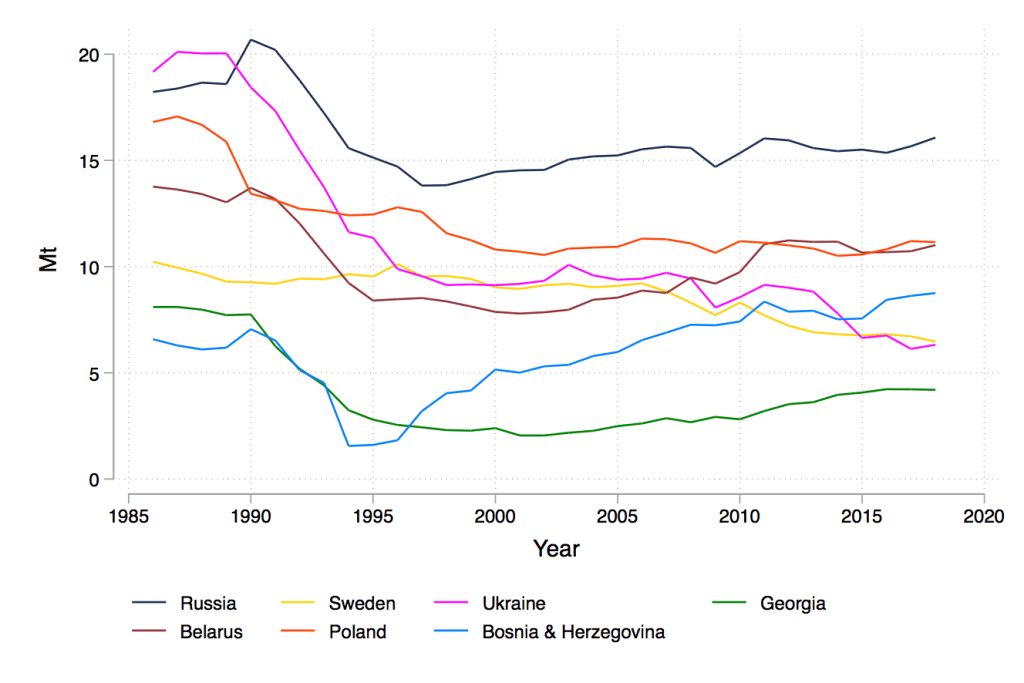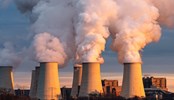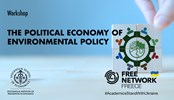How will climate change and the need for energy transformation affect environmental policy in Eastern Europe?
Highlights from the annual SITE Development Day conference 2021: Environmental Policy in Eastern Europe
Climate Policy in Russia
The first section of the conference was devoted to environmental policy in Russia. As Russia is one of the largest exporters of fossil fuel in the world, its policies carry particular importance in the context of global warming.
The head of climate and green energy at the Center for Strategic Research in Moscow, Irina Pominova, gave an account of Russia’s current situation and trends. Similar to all former Soviet Union countries, as seen in Figure 1, Russia had a sharp decrease in greenhouse gas emissions (hereinafter referred to as GHG emissions) during the early 90s due to the dramatic drop in production following the collapse of the Soviet Union. Since then, the level has stabilized, and today Russia contributes to about 5% of the total GHG emissions globally. The primary source of GHG emissions in Russia comes from the energy sector, mainly natural gas but also oil and coal. The abundance of fossil fuels has also hampered investments in renewable resources, constituting only about 3% of the energy balance, compared to the global average of 10%
Figure 1. Annual greenhouse gas emissions per capita.

Note: Greenhouse gas emissions are expressed in metric tons of CO2 equivalents. Source: Emissions Database for Global Atmospheric Research (EDGAR).
Pominova noted that it is a massive challenge for the country to reach global energy transformation targets since the energy sector accounts for over 20% of national GDP and 28% of the federal budget. Yet, on a positive note, the number of enacted climate policies has accelerated since Russia signed the Paris Agreement in 2019. One notable example is the federal law on the limitation of GHG emissions. This law will be enforced from the end of 2021 and will impose reporting requirements for the country’s largest emitters. The country’s current national climate target for 2030 is to decrease GHG emissions by 30% compared to the 1990 level. As shown in Figure 1, this would imply roughly a 10 percent reduction from today’s levels given the substantial drop in emissions in the 1990’s.
Natalya Volchkova, Policy Director at CEFIR in Moscow, discussed energy intensity and the vital role it fills in Russia’s environmental transition. Energy intensity measures an economy’s energy efficiency and is defined as units of energy per unit of GDP produced. Volchkova emphasized that to facilitate growth in an environmentally sustainable way it is key to invest in technology that improves energy efficiency. Several regulatory policy tools are in place to promote such improvements like bottom-line energy efficiency requirements, sectoral regulation, and bans on energy-inefficient technologies. Yet, more is needed, and a system for codification and certification of the most environmentally friendly technologies is among further reforms under consideration.
As a Senior Program Manager at SIDA, Jan Johansson provided insights on this issue from an international perspective. Johansson gave an overview of SIDA’s cooperation with Russia in supporting and promoting environmental and climate policies in the country. The main financial vehicle of Swedish support to Russia with respect to environmental policy has been a multilateral trust fund established in 2002 under the European Union (EU) Northern Dimension Environmental Partnership (NDEP). One of the primary objectives of the cooperation has been to improve the environment in the Baltic and Barents Seas Region of the Northern Dimension Area. Over 30 NDEP projects in Russia and Belarus have been approved for financing so far. Seventeen of those have been completed, and the vast majority have focused on improving the wastewater treatment sector.
Johansson also shed light on the differences that can exist between governments in their approach to environmental policy. For example, in the area of solid waste management, Russia prefers large-scale solutions such as landfills and ample sorting facilities. In Sweden and Western Europe, governments have a more holistic view founded on spreading awareness in the population, recycling, corporate responsibility, and sorting at the source.
Environmental Transition in Eastern Europe
In the second part of the conference environmental policies and energy transformation in several other countries in the region were discussed.
Norberto Pignatti, Associate Professor and Centre Director at ISET Policy Institute, talked about the potential for a sustainable energy sector and current environmental challenges in Georgia. The country is endowed with an abundance of rivers and sun exposure, making it a well-suited environment for establishing the production of renewable energy such as wind, solar, and hydro. As much as 95 % of domestic energy production comes from renewable sources. Yet, domestic energy production only accounts for 21% of the country’s total consumption, and 58% of imported energy comes from natural gas and 33% from coal. Furthermore, the capacity of renewable energy sources has declined over the last ten years, and particularly so for biofuel due to the mismanagement of forests. A notable obstacle Georgia faces in its environmental transition is attracting investors. Low transparency and inclusiveness from the government in discussions about environmental policy, along with inaccurate information from the media, has led to a low public willingness to pay for such projects. Apart from measures to overcome the challenges mentioned, the government is currently working on a plan to impose emission targets on specific sectors, invest in energy efficiency and infrastructure, and support the development of the renewable energy sector.
Like Georgia, Poland is a country where energy consumption is heavily reliant on imports and where coal, oil, and gas stand for most of the energy supply. On top of that, Poland faces significant challenges with air quality and smog and a carbon-intensive energy sector. On the positive end, Poland established a government-industry collaboration in September 2021, that recognizes offshore wind as the primary strategic direction of the energy transition in Poland. Pawel Wróbel, Founder and Managing Director of BalticWind.EU, explained that the impact of the partnership will be huge in terms of not only energy security but also job creation and smog mitigation. The plan implies the installation of 5.9 GW of offshore wind capacity by 2030 and 11GW by 2040. Wróbel also talked about the EU’s European Green Deal and its instrumental role in accelerating the energy transition in Poland. By combining EU-wide instruments with tailor-made approaches for each of the member states, the Deal targets a 55% reduction in GHG emissions by 2030 through decarbonization, energy efficiency, and expanding renewable energy generation. Michal Myck, Director of CenEA, highlighted the role of social acceptance in accelerating the much-needed energy transition in Poland. In particular, to build political support, there is a crucial need for designing carbon taxes in a way that ensures the protection of vulnerable households from high energy prices.
Adapting to the European Green Deal will also create challenges for countries outside of the EU, especially if a European Carbon Border Adjustment Mechanisms (CBAM) is put in place in 2026 as suggested. Two participants touched on this topic in the context of Belarus and Ukraine respectively. Yauheniya Shershunovic, researcher at BEROC, talked about her research on the economic implications of CBAM in Belarus. It is estimated that the introduction of CBAM can be equivalent to an additional import duty on Belarusian goods equal to 3.4-3.8% for inorganic chemicals and fertilizers, 6.7-13.7% for metals, and 6.5-6.6% for mineral products. Maxim Fedoseenko, Head of Strategic Projects at KSE, shared similar estimations for Ukraine, suggesting that the implementation of CBAM will lead to an annual loss of €396 million for Ukrainian businesses and a decrease in national GDP of 0.08% per year.
An example of Swedish support to strengthen environmental policies in Eastern Europe was presented by Bernardas Padegimas, Team Leader at the Environmental Policy and Strategy Team at the Stockholm Environment Institute. The BiH ESAP 2030+ project is supporting Bosnia and Herzegovina in preparing their environmental strategy. This task is made more challenging by the country’s unique political structure with two to some extent politically autonomous entities (and a district jointly administered by the two), and elites from the three different major ethnic groups having guaranteed a share of power. The project therefore aims to include a broad range of stakeholders in the process, organized into seven different working groups with 659 members on topics ranging from waste management to air quality, climate change and energy. The project also builds capacity in targeted government authorities, raises public awareness of environmental problems, and goes beyond just environmental objectives: mainstreaming gender equality, social equity and poverty reduction. The project is 80 percent finished and will produce a strategy and action plan for the different levels of governance in the country’s political system. There is also a hope that this process can serve as a model for consensus building around important but at times contentious policy issues more generally in the country.
Public Opinion and Energy Security
Finally, Elena Paltseva, Associate Professor at SITE, and Chloé le Coq, Professor at the University of Paris II Panthéon-Asses (CRED), shared two joint studies relating to the green transition in Europe.
Recent research shows that individual behavioral change has a vital role to play in the fight against climate change, both directly and indirectly through changes in societal attitudes and policies motivated by role models. A precondition for this to happen is a broad public recognition of anthropogenic climate change and its consequences for the environment. The first presentation by Paltseva and Le Coq focused on public perceptions about climate change in Europe (see this FREE policy brief for a detailed account). Using survey data the study explores variation in climate risk perceptions between Western Europe, the non-EU part of Eastern Europe, and Eastern European countries that are EU members. The results show that those living in non-EU Eastern European countries are on average less concerned about climate change. The regional difference can partly be explained by low salience and informativeness of environmental issues in the public discourse in these countries. To support this explanation, they study the impact of extreme weather events on opinions on climate change with the rationale that people who are more aware of climate change risks are less likely to adjust their opinion after experiencing an extreme weather event. They find that the effect of extreme weather events is higher in countries with less independent media and fewer climate-related legislative efforts, suggesting that the political salience of the environment and the credibility of public messages affects individuals’ perceptions of climate change risks.
The second presentation concerned energy security in the EU, and the impact of the environmental transition. It was argued that natural gas will play an important role in Europe’s green transition for two reasons. First, since the transition implies a higher reliance on intermittent renewable energy sources, there will be an increased need for use of gas-fired power plants to strengthen the supply reliability. Second, the electrification of the economy along with the phasing out of coal, oil, and nuclear generation plants will increase the energy demand. Today, about 20% of EU’s electricity comes from natural gas and 90% of that gas comes from outside EU, with 43% coming from Russia. To emphasize what issues can arise when the EU relies heavily on external suppliers, the presentation discussed a Risky External Energy Supply Index (Le Coq and Paltseva, 2009) that considers the short-term impact of energy supply disruptions. This index assesses not only the importance of the energy type used by a country but also access to different energy suppliers (risk diversification). The index illustrates that natural gas is riskier than oil or coal since natural gas importers in the EU depend to a greater extent on a single or few suppliers. Another crucial component of the security of gas supplies arises from the fact that 77% of EU’s net gas imports arrive through pipelines, which creates an additional risk of transit. Here, the introduction of new gas transit routes (from already existing suppliers) may increase diversification and decrease risks to the countries having direct access to the new route. At the same time, countries that share other pipelines with countries that now have direct access may lose bargaining power vis-à-vis the gas supplier in question, as demand through those pipelines could fall. Le Coq illustrated this point applying the Transit Risk Index developed in Le Coq and Paltseva (2012) to the introduction of the North Stream 1 pipeline. She concluded that the green transition and associated increase in demand for natural gas is likely to be associated with higher reliance on large gas producers, such as Russia, and resulting in energy security risks and imbalance in the EU. One way to counteract this effect is to exercise EU’s buyer power vis-a-vis Russia within the EU common energy policy. While long discussed, this policy has not been fully implemented so far.
Concluding Remarks
This year’s SITE Development Day conference gave us an opportunity to highlight yet another key issue, not only for Eastern Europe, but for the whole world: global warming and energy transformation. Experts from across the region, and policymakers and scholars based in Sweden, offered their perspectives on the challenges that lie ahead, but also highlighted initiatives and investments hopefully leading the way towards a brighter future.
List of participants
Disclaimer: Opinions expressed in events, policy briefs, working papers and other publications are those of the authors and/or speakers; they do not necessarily reflect those of SITE, the FREE Network and its research institutes.




